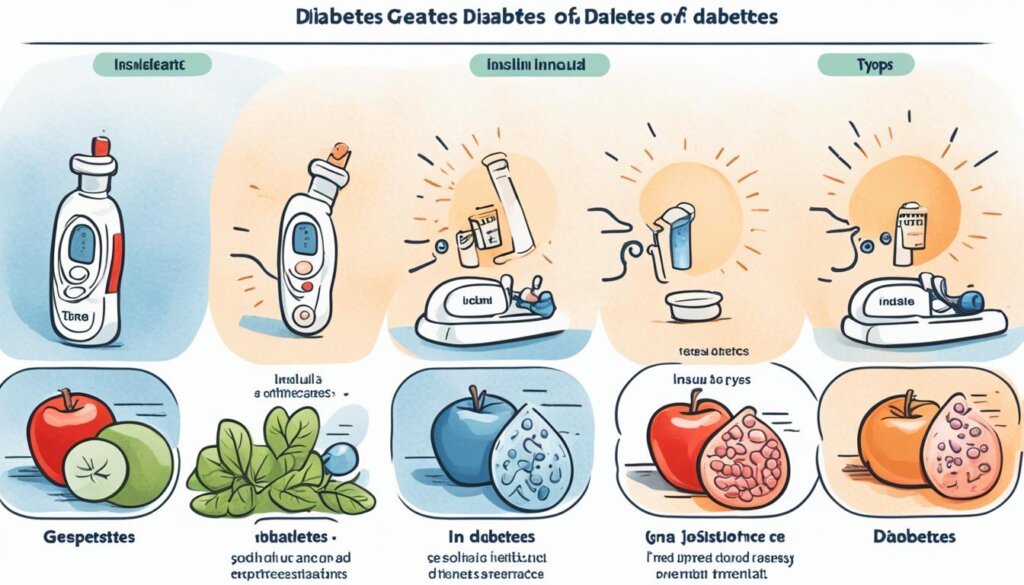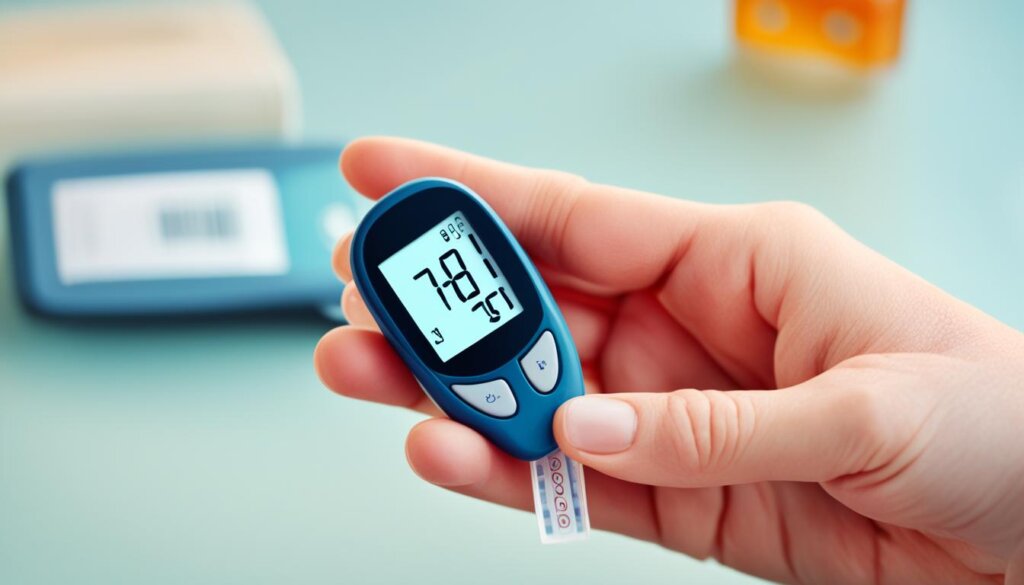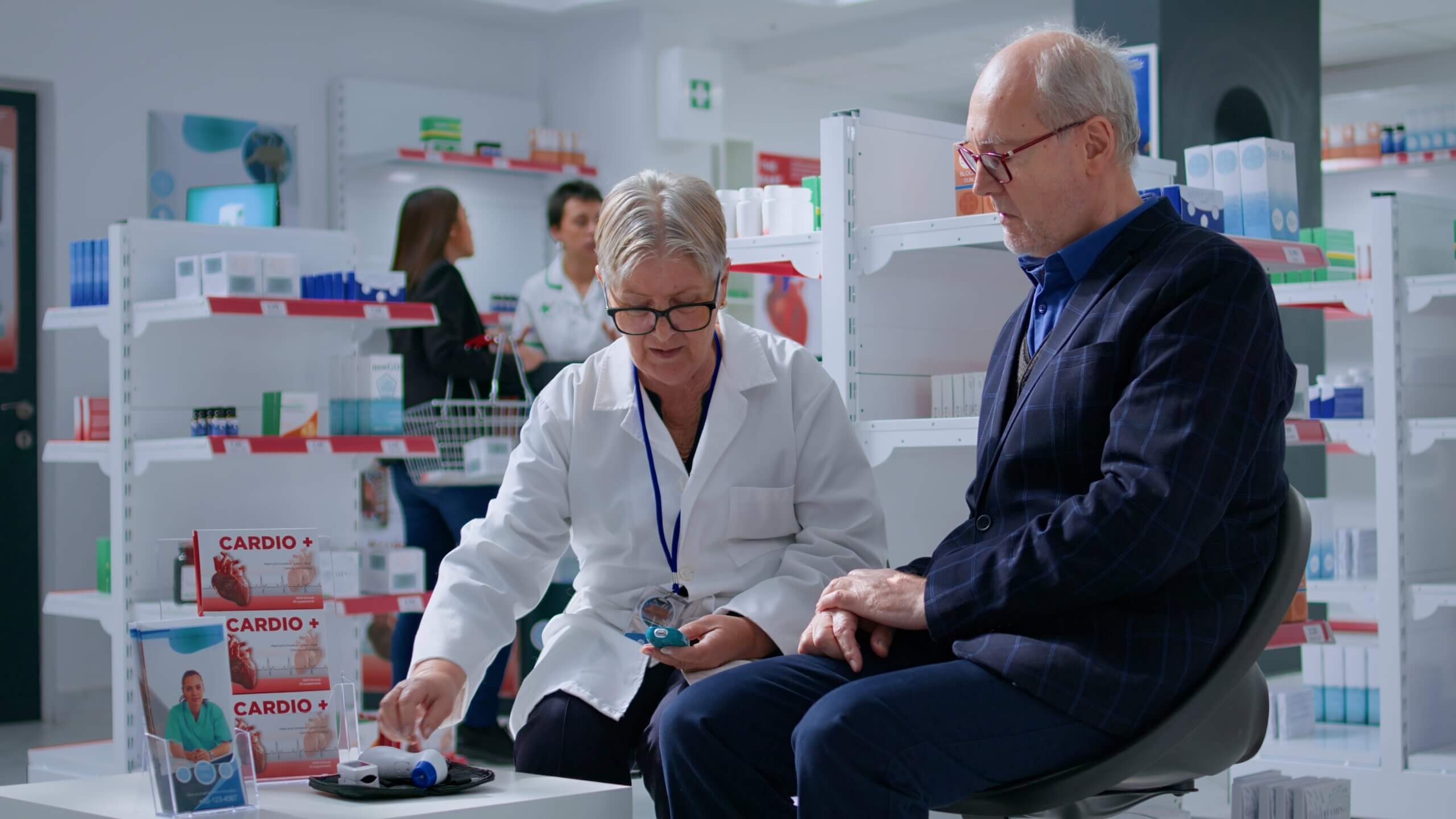FTC disclaimer: This post may contains affiliate links and we will be compensated if you click on a link and make a purchase.
Did you know 37.3 million Americans, or 11.3% of the population, have diabetes? It’s key to know about blood glucose levels to manage diabetes well. This is true whether you have diabetes, are at risk, or want to stay healthy.
Key Takeaways
- A healthy fasting blood glucose level ranges from 70 to 99 mg/dL
- Prediabetes is indicated by fasting blood glucose levels of 100 to 125 mg/dL
- Diabetes is typically diagnosed when fasting blood glucose is 126 mg/dL or higher
- Maintaining A1C levels below 7% is the target for most adults with diabetes
- Regular blood glucose monitoring is essential for managing diabetes and overall health
This guide will cover everything you need to know about blood glucose levels. You’ll learn how to take charge of your health and make smart choices for diabetes management. We’ll cover the basics of insulin and the different types of diabetes. This will help you understand this important part of your health.
What Are Blood Glucose Levels?
Glucose and Insulin
Blood glucose is the sugar in your blood. It comes from the food you eat and is your main energy source. Insulin is a hormone made by your pancreas. It helps your cells use glucose for energy.
When you eat carbs, your body turns them into glucose. This glucose goes into your bloodstream. Insulin helps move glucose from your blood into your cells. This keeps your blood glucose levels in check.
Healthy blood sugar levels are below 100 mg/dL after fasting and under 140 mg/dL 2 hours after eating. For most, blood sugar is around 70 to 80 mg/dL before meals. Normal fasting levels are between 72 and 99 mg/dL.
The American Diabetes Association (ADA) says fasting blood glucose for type 2 diabetes should be 80–130 mg/dL. The American Association of Clinical Endocrinologists (AACE) suggests it should be less than 110 mg/dL. The ADA also says blood glucose should be under 180 mg/dL 2 hours after eating. The AACE recommends it should be less than 140 mg/dL at the same time.
The normal fasting blood glucose level is 70-99 mg/dL (3.9-5.5 mmol/L). The normal random blood glucose level is usually 125 mg/dL (6.9 mmol/L) or lower. If it’s 100-125 mg/dL (5.6-6.9 mmol/L), it means you might have prediabetes.
If your fasting blood glucose is 126 mg/dL (7 mmol/L) or higher, or your random blood glucose is 200 mg/dL (11 mmol/L) or higher, you have diabetes.
The Role of Diabetes
Diabetes is a chronic condition that affects how your body handles blood sugar. It happens when your body can’t make insulin or use it well. This leads to too much glucose in your blood, causing high levels. There are different types like type 1, type 2, and gestational diabetes, each needing its own care.
Prediabetes means your blood sugar is higher than normal but not high enough to be diabetes. People with prediabetes are at risk for type 2 diabetes, heart disease, and stroke. Catching and managing prediabetes can stop it from becoming full diabetes and its problems.
Insulin resistance is a big part of type 2 diabetes. When your cells don’t respond to insulin, your body can’t use the glucose in your blood, causing high sugar levels. Eating right and exercising can make your body more sensitive to insulin, lowering the risk of type 2 diabetes.

Knowing how diabetes affects your health is key. By spotting signs of high or low blood sugar and managing it, you can control your health and lower the risk of serious problems.
Blood Glucose Targets for Diabetes | Target Range |
|---|---|
Before a meal | 80 to 130 mg/dL |
Two hours after the start of a meal | Less than 180 mg/dL |
“Diabetes is a serious condition that requires ongoing management, but with the right approach, you can live a healthy and fulfilling life.”
Managing diabetes or prediabetes is a long journey. But with the right knowledge and support, you can improve your health and well-being.
Types of Diabetes
Diabetes is a complex condition with several types. It’s important to know the different forms of good management and prevention. The main types of diabetes include:
- Type 1 diabetes: Your body stops making insulin, a hormone needed for blood sugar control.
- Type 2 diabetes: Your body doesn’t make enough insulin or can’t use it well, a condition called insulin resistance.
- Gestational diabetes: This type of diabetes happens during pregnancy and usually goes away after the baby is born.
- Prediabetes: Your blood sugar levels are higher than normal but not high enough for diabetes. This increases your risk of getting type 2 diabetes.
It’s key to know the unique traits and risk factors of each diabetes type for good health and prevention. 
“Knowing the different types of diabetes is the first step towards effective management and prevention.”
Learning about the various diabetes types helps you watch your health, get the right treatment, and change your lifestyle to lower your risk.
When to Check Blood Glucose Levels
If you have diabetes, checking your blood glucose often is key. It’s very important for those who use insulin to control their diabetes. Testing at the right times helps you see how your body reacts to different things. This lets you make smart choices about managing your diabetes.
Optimal Times for Checking
Your doctor will tell you the best times to test your blood glucose. Some good times include:
- Fasting (when you wake up or haven’t eaten for 8-12 hours)
- Before and after meals to see the impact of food
- Before all meals to figure out insulin doses
- At bedtime
Many things can change your blood sugar levels, like what you eat, your meds, how much you move, stress, certain medicines, and smoking. Things like growing up, missing meals, taking too much medicine or insulin, and being active can also change your levels. Your levels can go up and down because of your period, when you eat, drink alcohol, and some medicines.
Writing down your blood sugar readings helps you and your doctor spot patterns. This can help you adjust your diabetes plan as needed.

“Regularly checking your blood glucose levels is essential for managing diabetes effectively.”
People with type 1 diabetes might test their blood sugar 4 to 10 times a day. This could be before meals, after eating, before and after exercise, before bed, during the night, and more when you’re sick or if you change your routine.
If you have type 2 diabetes and use insulin, you might test several times a day. How often depends on the type and amount of insulin you take, like before meals and at night if you take more shots.
Diabetes Type | Recommended Blood Glucose Testing Frequency |
|---|---|
Type 1 Diabetes | 4 to 10 times per day |
Type 2 Diabetes (insulin-dependent) | Several times per day |
Continuous glucose monitoring (CGM) devices help people with type 1 diabetes check their blood sugar all day. CGMs might need to be calibrated and could require finger-stick tests. Newer CGMs work better with some medicines, like Tylenol and vitamin C, than older ones.
Knowing when to check your blood glucose helps you manage your diabetes better. It lets you work closely with your doctor for the best results.
Recommended Blood Glucose Targets
Keeping blood glucose levels healthy is key to managing diabetes and avoiding problems. The American Diabetes Association (ADA) and the American Association of Clinical Endocrinologists (AACE) have set guidelines for adults with type 2 diabetes.
The ADA says the fasting blood glucose should be between 80-130 mg/dL. The AACE recommends it should be less than 110 mg/dL. For blood glucose after eating, the ADA wants it below 180 mg/dL. The AACE suggests it should be less than 140 mg/dL.
It’s important to talk with your doctor to find the right targets for you. They consider your health, medicines, and lifestyle to set targets.
Measurement | ADA Recommendation | AACE Recommendation |
|---|---|---|
Fasting Blood Glucose | 80-130 mg/dL | |
Post-Meal Blood Glucose |
Staying within these blood glucose ranges lowers the risk of diabetes problems and boosts health.

How to Check Blood Glucose Levels
Checking your blood glucose levels is key to managing diabetes. There are many ways to do this at home, each with its own benefits. Learning about these options can help you pick the best one for you.
Blood Glucose Monitors
Using a blood glucose monitor is a common way to check your sugar levels. These devices prick your finger with a small lancet. Then, they analyze a drop of blood to show your glucose level. You can store many readings on these meters to track your levels over time.
Continuous Glucose Monitors (CGMs)
Continuous glucose monitoring (CGM) systems are a more advanced way to track your blood sugar. They have a small sensor under your skin that measures your glucose levels all the time. This data goes to a monitor or an app on your phone. CGMs give you real-time readings, showing how your levels change all day and night.
When choosing the best glucose monitor, talk to your healthcare provider. They can help pick the right one for you, considering your diabetes type, lifestyle, and goals.
“Regular blood glucose monitoring is crucial for managing diabetes and reducing the risk of complications. It helps you and your healthcare team understand your trends and make necessary adjustments to your treatment plan.”
High Blood Glucose Levels (Hyperglycemia)
Hyperglycemia, or high blood sugar, happens when your body can’t make enough insulin or use it right. This leads to symptoms like more thirst, feeling tired, blurry vision, headaches, and needing to pee a lot. High blood sugar often means you need to change your diabetes plan.
There are many reasons for hyperglycemia, like being overweight, not moving much, eating too many processed carbs and fats, some medicines, certain health conditions, and your genes. Wrong insulin doses, not balancing carbs and insulin, and not being active can also cause it in people with diabetes.
If hyperglycemia is not treated, it can cause big problems. These include harming blood vessels and tissues, raising the chance of heart disease, nerve damage, kidney disease, and eye problems. In the worst cases, it can lead to serious conditions like diabetic ketoacidosis (DKA) and hyperosmolar hyperglycemic state (HHS).
To handle hyperglycemia, working with your doctor to find the right treatment is key. This might mean eating differently, managing your weight, exercising, and changing your meds. Keeping an eye on your blood sugar, taking your meds as told, and sticking to your diabetes plan can stop and control high blood sugar.
Condition | Defining Hyperglycemia | Prevalence |
|---|---|---|
Diabetes | Blood glucose greater than 125 mg/dL while fasting and greater than 180 mg/dL 2 hours postprandial | Nearly 30.5 million Americans have diabetes, and nearly 84 million Americans have prediabetes. |
General Population | Blood glucose levels surpassing 180 to 200 milligrams per deciliter (mg/dL) or 10 to 11.1 millimoles per liter (mmol/L) | The prevalence of hyperglycemia is equal between men and women. |
Keeping up with your diabetes plan, checking your blood sugar often, and listening to your doctor are key steps to prevent and manage high blood sugar. By acting early, people with high blood sugar can keep their levels in check and lower the risk of serious problems.
Blood Glucose Levels
Knowing your blood glucose levels is key to staying healthy. A normal fasting blood glucose level is 70 to 99 mg/dL. This range is what you aim for to keep your blood sugar stable. If it’s between 100 to 125 mg/dL, you might have prediabetes, which means you’re at risk of getting type 2 diabetes. If it’s 126 mg/dL or higher on more than one test, you likely have diabetes. Your doctor will check this with an A1C test.
Keeping your blood sugar in check is vital for your health. The American Diabetes Association says to keep it between 80 to 130 mg/dL before meals. If it’s over 180 mg/dL 2 hours after eating, it’s too high. High blood sugar can make you thirsty, make you pee a lot, blur your vision, and make you tired. If it stays high, you might get type 2 diabetes.
Blood Glucose Levels | Target Ranges |
|---|---|
Fasting | 70 to 99 mg/dL |
Before Meals | 80 to 130 mg/dL |
2 Hours After Meals | Less than 180 mg/dL |
Checking your blood glucose often is key to managing diabetes, especially if you use insulin. Continuous glucose monitoring (CGM) is another way to keep track of your levels for better control. To keep your blood sugar healthy, eat well, exercise regularly, and check your levels often to avoid problems.
“Cognitive decline has been linked to extremely high or low blood glucose levels, impacting brain function in people with diabetes.”
People with diabetes face risks of both high and low blood sugar. Early signs of low blood sugar include shaking, sweating, feeling anxious, and a fast heart rate. If it gets very low, it can cause confusion, seizures, and even loss of consciousness, which can be dangerous.
The glycemic index (GI) tells you how foods affect your blood sugar. High GI foods cause big spikes, while low GI foods give you energy slowly. Checking your blood glucose often is important for managing diabetes, especially if you use insulin. Continuous glucose monitoring (CGM) is another way to keep track of your levels for better control.
Low Blood Glucose Levels (Hypoglycemia)
Treating Low Blood Sugar
Hypoglycemia means your blood sugar is too low, below 70 mg/dL. It often happens if you have diabetes and use certain medicines, like insulin. Signs include feeling shaky, sweating, being confused, and dizzy.
To treat low blood sugar, try the “15-15” method: eat 15 grams of carbs and wait 15 minutes to check your levels. If it’s very bad, you might need to use injectable glucagon to help raise your blood sugar fast. Always talk to your doctor to prevent and handle low blood sugar.
Not treating hypoglycemia can lead to seizures, coma, or even death. If you often have low blood sugar, you might not feel the usual signs, making it more dangerous. To fix this, change your treatment and learn more about your blood sugar.
To stop hypoglycemia, follow a diabetes plan, know the signs of low blood sugar, use a glucose monitor, stick to your diet and medicine, and carry quick carbs like juice or glucose tablets.
Low blood sugar is usually easy to fix, but very low levels can be serious. People with diabetes, especially those on insulin or certain medicines, are more likely to get hypoglycemia. Knowing about low blood sugar can help you manage your diabetes better and avoid dangerous episodes.
Managing Blood Glucose Levels
Keeping your blood glucose levels healthy is key. It means eating right and staying active. By choosing healthy habits, you can keep your blood sugar where it should be.
Diet and Exercise
Eat lots of veggies, fruits, whole grains, lean meats, and healthy fats. Cut down on sugary foods, drinks, and bad fats. Drinks like soda and juice can make your blood sugar go up fast. So, drink them less if you have diabetes.
Try to move more, like walking fast, for at least 150 minutes a week. If your blood sugar is low, eating a snack with carbs before you exercise can help.
Check your blood sugar before, during, and after you exercise. This is especially true if you use insulin or other diabetes medicines. Change your medicine as needed to keep your blood sugar right.
Living a healthy life with good food and exercise helps manage your blood sugar. Work with your doctor to make a plan that fits you best.
“The key to managing diabetes is to create a sustainable lifestyle that includes a balanced diet, regular exercise, and close monitoring of blood glucose levels.”
Conclusion
Keeping an eye on your blood glucose levels is key to managing diabetes. By knowing what affects your blood sugar, checking it often, and following a good diabetes plan, you can help control your health. This can lower the risk of serious problems.
It’s important to work with your doctor and use resources like diabetes education and support groups. Making changes in your lifestyle can also help keep your blood sugar in check. With hard work and being proactive, you can manage your blood glucose well and take charge of your diabetes.
Keeping your blood glucose at the right level is crucial to avoid serious health issues like heart disease, nerve damage, and kidney problems. By focusing on blood glucose management, diabetes self-care, and using all the diabetes resources out there, you can live a better life with diabetes.
FAQ
What are blood glucose levels?
Blood glucose, or blood sugar, is the sugar in your blood. It comes from what you eat and gives your body energy.
How does diabetes affect blood glucose levels?
Diabetes makes it hard for your body to control blood sugar. This happens when your body can’t make enough insulin or can’t use it right. So, sugar builds up in your blood instead of being used.
What are the main types of diabetes?
There are mainly three types of diabetes. Type 1 is when your body doesn’t make insulin. Type 2 is when your body doesn’t make enough insulin or can’t use it well. Gestational diabetes happens during pregnancy and usually goes away after the baby is born.
When should I check my blood glucose levels?
If you have diabetes, you should check your blood sugar often. Good times to check are when you wake up, before and after meals, and at bedtime.
What are the recommended blood glucose targets?
The American Diabetes Association (ADA) and the American Association of Clinical Endocrinologists (AACE) have different targets for blood sugar. The ADA says fasting levels should be 80-130 mg/dL.
How can I check my blood glucose levels at home?
You can check your blood sugar at home with blood glucose monitors or continuous glucose monitors (CGMs). Monitors use a lancet to prick your finger, and CGMs have a sensor under your skin to track your glucose levels.
What are the symptoms of high blood glucose levels (hyperglycemia)?
High blood sugar can make you thirsty, tired, have blurry vision, give you headaches, and make you pee a lot. If your blood sugar is always high, you need to adjust your diabetes plan.
What are the symptoms of low blood glucose levels (hypoglycemia)?
Low blood sugar can make you shaky, sweaty, confused, and dizzy. To fix it, eat 15 grams of carbohydrates and wait 15 minutes. In bad cases, you might need injectable glucagon.
How can I manage my blood glucose levels?
To keep your blood sugar healthy, eat well, exercise regularly, and take any medicines your doctor says you need. Work with your healthcare team to make a plan that fits your life.








